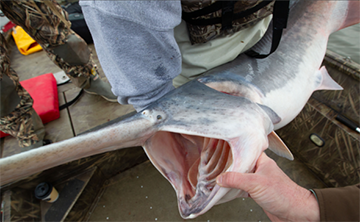JEFFERSON CITY, Mo. — Imagine catching a giant, prehistoric fish whose ancestors swam during the time of dinosaurs. That is a reality for thousands of paddlefish snaggers during Missouri’s annual spring paddlefish season. Missouri’s official state aquatic animal, the paddlefish is highly valued as a sport fish.

Paddlefish are named for their large, paddle-shaped snouts. Paddlefish swim slowly through water with their mouths wide open, collecting tiny crustaceans and insects in their elaborate, closely set gill rakers.
The season for the state’s major paddlefish waters — Lake of the Ozarks, Harry S. Truman Reservoir, and Table Rock Lake – along with most other waters in the state runs March 15 through April 30. The season for the Mississippi River is March 15 through May 15 with a fall season of Sept. 15 through Dec. 15.
Paddlefish — named for their large, paddle-shaped snouts — are an ancient species that can grow to seven feet and weigh more than 100 pounds. Paddlefish swim slowly through water with their mouths wide open, collecting tiny crustaceans and insects in their elaborate, closely set gill rakers. The paddle-shaped snout functions as an electrosensory organ that allows it to sense plankton as it swims through water.
Because the giant fish eat tiny crustaceans and insects, they do not bite on traditional fishing hooks. The are usually caught through the practice of snagging where anglers drag large triple-sided hooks through the water to “snag” a fish in the body with the hooks.
A fishing permit is required for snagging and other allowed methods, unless exempt. The daily limit is two paddlefish, and the possession limit is four. No person shall continue to snag after taking a daily limit of two paddlefish.
The statewide minimum length limit is 32 inches — measured from eye to fork of tail – with a minimum length limit of 34 inches for Lake of the Ozarks, Table Rock Lake, Harry S. Truman Reservoir, and their tributaries.
All paddlefish under the legal minimum length must be returned to the water unharmed immediately after being caught. MDC offers these tips for returning undersized fish:
- Use landing nets, not gaffs, which can kill young fish.
- Wet hands before handling fish and avoid excessive handling.
- Never put fingers in the gills or eyes.
- Remove hooks carefully and get undersized fish back into the water as quickly as possible.
Cleaning paddlefish while on the water, dumping the carcass overboard, and returning to shore with fillets and/or eggs is illegal. Extracted paddlefish eggs may not be possessed while on waters of the state or adjacent banks and may not be transported. Paddlefish eggs may not be bought, sold, or offered for sale. These regulations are necessary to confirm length-limit requirements and to address the illegal caviar trade.
Snaggers and others are allowed to haul paddlefish carcasses out by boat to deeper water for disposal under the following conditions:
- The head, tail, etc. must remain intact so the fish could be measured if contacted by a conservation agent.
- Extracted eggs must remain where the fish is cleaned and cannot be transported to deeper water for disposal.
- Paddlefish fillets cannot be possessed or transported on the water.
Learn more about paddlefish, snagging regulations, snagging reports, and more at mdc.mo.gov/fishing/species/paddlefish.
